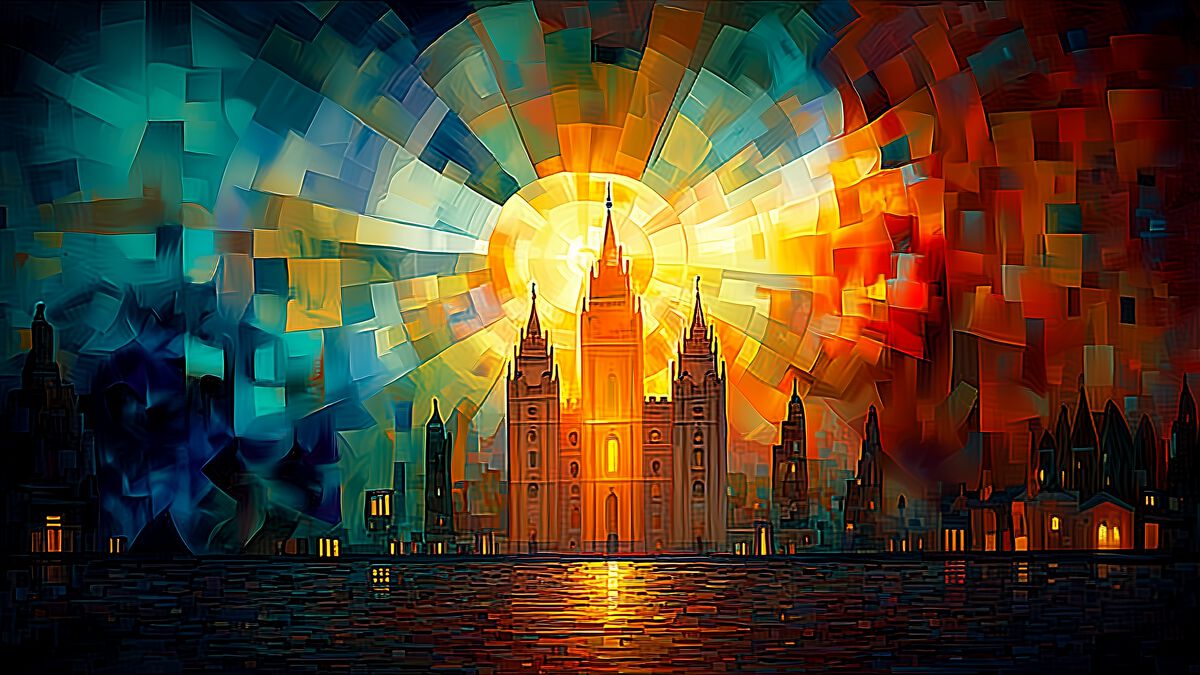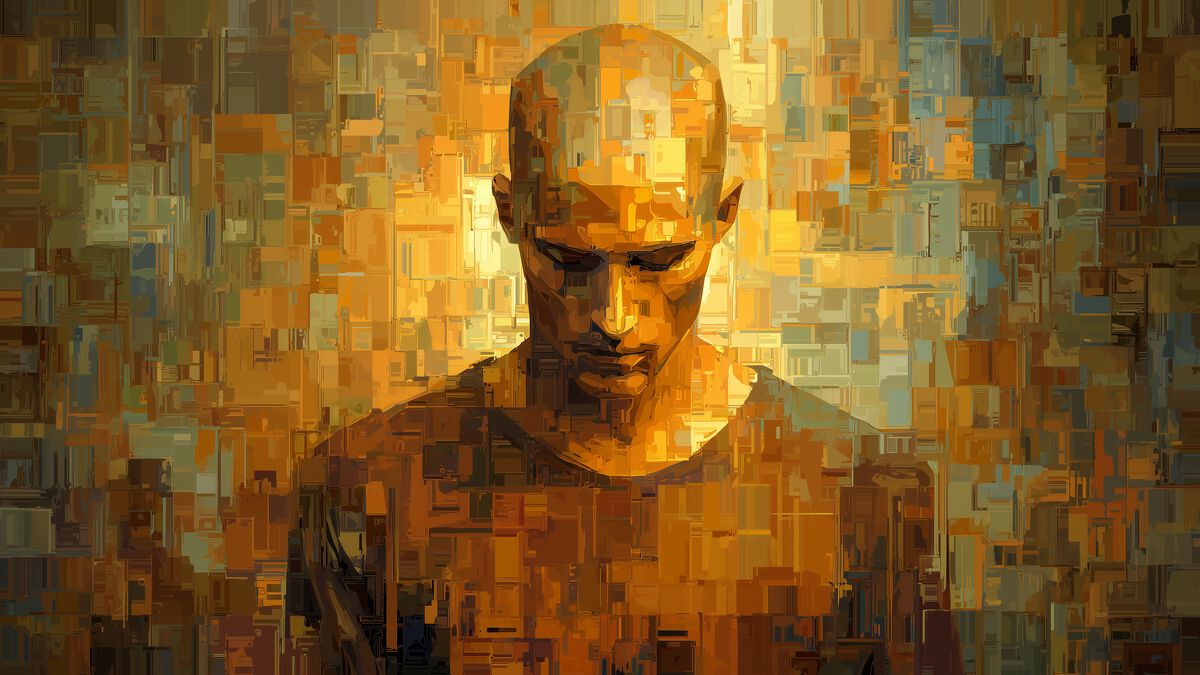Transfigurism: Mormonism as Religious Transhumanism
Lincoln Cannon
29 April 2007 (updated 7 October 2025)
This is an edited transcript of a presentation about Mormonism as a Religious Transhumanism that I gave, via my avatar Ahman Hax, on Uvvy Island in the virtual world of Second Life. The occasion was a seminar on Transhumanism and religion. Attendees consisted mostly of secular Transhumanists. I gave a revised version of this presentation in 2008.
Hello everyone. My First Life name is Lincoln Cannon, and I am President of the Mormon Transhumanist Association, and a proud member of the World Transhumanist Association, as are all voting members of the Mormon Transhumanist Association.
My presentation, today, is a supportive response to James Hughes’ document on “The Compatibility of Religious and Transhumanist Views of Metaphysics, Suffering, Virtue and Transcendence in an Enhanced Future.” In that document, James provides supporting evidence from a variety of religious traditions, particularly Buddhism, and classifies the evidence into categories of metaphysics, theodicy, eschatology and soteriology.
In the eschatology category, James refers to a document, from the Mormon Transhumanist Association, which focuses on Transhumanist parallels with Mormon eschatology. That document does not consider Transhumanist parallels with Mormon metaphysics, theodicy, or soteriology; however, that is not for any lack of similarities in these areas.
My objective is to provide you a broader perspective on the compatibility of Mormon and Transhumanist views. I will begin by providing, briefly, some background information on Mormon origins and denominations. Subsequently, I will describe Mormon metaphysics, theodicy, eschatology and soteriology with an emphasis on aspects that resonate strongly with Transhumanism.
Please understand that not all Mormons will fully agree with everything I present. Like Transhumanists, Mormons sometimes disagree with each other. For evidence of this, you need look no further than the divergent perspectives of prominent American politicians, Harry Reid and Mitt Romney. Reid is one of the highest ranking Democrats in the United States government, and Romney is a Republican contender for the next presidency of the United States, yet both are Mormon.
Be assured, however, that my presentation, today, will reflect an authentic Mormon view, supported both by Mormon tradition and by Mormon canon, as well as the sincere commitment of many individual Mormons, whether familiar with Transhumanism or not.
Additionally, please note that I will assume you, observing this presentation, are already familiar with Transhumanism, and so will not elaborate on Transhumanist ideas except to the extent of explicitly calling out similarities with Mormon ideas.
Mormon Origins and Denominations
Mormonism originates with early nineteenth-century American, Joseph Smith. Joseph, as he liked to be called, claimed to communicate with God through visions and other experiences, beginning in his adolescence and continuing throughout his life. In 1830, Joseph published the Book of Mormon, which tells of interactions between God and ancient inhabitants of the American continent, including a visit from the resurrected Jesus Christ. Soon after publishing the book, Joseph founded the Church of Christ as a restoration of the original Christian church.
Following years of violent persecution, Joseph was killed by a mob in 1844, and the already-strained church fractured. In time, Brigham Young emerged as the recognized leader of the majority of Mormons, who he led across the plains and mountains of the American west to settle in the valleys of what has become the State of Utah. The Church of Jesus Christ of Latter-day Saints was incorporated in 1851, and today consists of over 13 million members around the world.
Simultaneously, most Mormons that did not follow Brigham eventually coalesced around the leadership of Joseph Smith III, the oldest surviving son of Joseph Smith. The Reorganized Church of Jesus Christ of Latter-day Saints was established in 1860, changed its name in 2001 to Community of Christ, and today consists of over 200,000 members worldwide.
In addition to these major Mormon denominations, there are numerous small denominations, such as the Fundamentalist Church of Jesus Christ of Latter-day Saints, which continues to practice polygamy, unlike most other Mormon denominations.
Mormon Metaphysics
There is no Mormon metaphysics.
More specifically, Mormonism does not rely on the immaterial. Joseph taught that “all spirit is matter, but it is more fine or pure.” Spirits, whether of humans, non-human animals or even whole worlds, are organized from light, which “was not created or made, neither indeed can be.” This light is a primal “intelligence,” “which is in all things, which giveth life to all things, which is the law by which all things are governed, even the power of God who sitteth upon his throne, who is in the bosom of eternity, who is in the midst of all things.”
God does not create the world from nothing. Rather, “God had materials to organize the world out of chaos – chaotic matter, which is element” The physical world extends and empowers the spiritual world. God creates “all things … first spiritual, secondly temporal.” Together, “the spirit and the body are the soul.”
“Spirit and element, inseparably connected, receive a fulness of joy; and when separated, [we] cannot receive a fulness of joy.” Indeed, “they who have [bodies], have power over those who have not.” The dead only have experience “in the abstract” and look “upon the long absence of their spirits from their bodies as a bondage.”
Additionally, Mormonism does not rely on the supernatural. “All [worlds] have a law given; and there are many [worlds]; for there is no space in the which there is no [world] … and unto every [world] is given a law; and unto every law there are certain bounds also and conditions.” Even the miraculous “cannot be in contravention of natural law, but [is] wrought through the operation of laws not universally or commonly recognized.” “The whole story of [our] progress is the conversion of ‘miracles’ into controlled and understood events.”
Mormonism’s materialism and naturalism situate it squarely in the empirical world of modern science. Certainly, respect for objectivity and acknowledgment of symbolism should inform Mormon interpretation of canonical texts and spiritual experiences, just as an open-minded restraint from dogmatism should inform skeptics’ interpretation. However, Mormons do adhere to a metaphysics (or really a lack of metaphysics) that is fundamentally consistent with that of many Transhumanists.
Mormon Theodicy
Mormon theodicy, its explanation for the mutual existence of God and evil, parts with theologies that postulate a monolithic God of absolute omnipotence.
While God has all possible power, the possible is limited. “Element had an existence from the time [God] had. The pure principles of element are principles which can never be destroyed; they may be organized and reorganized, but not destroyed. They had no beginning and can have no end.” Likewise, “intelligence, or the light of truth, was not created or made, neither indeed can be.” “The spirit … is not a created being; it existed from eternity, and will exist to eternity.”
God did not create the world from nothing, rather God emerged “in the midst of spirits and glory” and being “more intelligent, saw proper to institute laws whereby the rest could have a privilege to advance … The relationship we have with God places us in a situation to advance in knowledge. [God] has power to institute laws to instruct the weaker intelligences, that they may be exalted.” Consequently, God’s power becomes distributed among all who become gods, of whom it is written, “they have all power.”
Evil arises from the tension and conflict between wills, desires and laws. There is no absolute good or evil. “That which is wrong under one circumstance, may be, and often is, right under another. God said, ‘Thou shalt not kill;’ at another time … ‘Thou shalt utterly destroy.’ This is the principle on which the government of heaven is conducted – by revelation adapted to the circumstances in which the children of the kingdom are placed.”
To overcome evil, God calls us to be saviors, of whom Jesus Christ “is the prototype or standard of salvation.” “Through the Atonement of Christ, all mankind may be saved.” Jesus teaches, “love one another, as I have loved you.” “If ye ask any thing in my name, I will do it. If ye love me, keep my commandments.”
Like the Apostle Paul, we are called to “fill up that which is behind of the afflictions of Christ in [our] flesh for his body’s sake, which is the church.” This is “Christ in you, the hope of glory: Whom we preach, warning [everyone], and teaching [everyone] in all wisdom; that we may present [everyone] perfect in Christ Jesus.”
Mormon theodicy appeals to a distribution of God’s power among divine persons that organize and reorganize the world in which they find themselves, as they seek to unite in compassion for each other. This view resonates with philanthropic, consequentialist, and democratic principles expressed in the Transhumanist Declaration.
Mormon Eschatology
Mormon eschatology, its view of the future, begins by identifying our time as one of wonderful progress and extraordinary challenges, and proceeds to a Millennial paradise and beyond to godhood in worlds without end.
We now live in an epoch known as the “dispensation of the fulness of times,” when God is building upon past knowledge and power to inspire and endow us with yet greater knowledge and power. “Nothing shall be withheld, whether there be one God or many gods, they shall be manifest … and also, if there be bounds set to the heavens or to the seas, or to the dry land, or to the sun, moon, or stars … all their glories, laws, and set times, shall be revealed.”
“And not only this, but those things which never have been revealed from the foundation of the world, but have been kept hid from the wise and prudent, shall be revealed unto babes and sucklings in this, the dispensation of the fulness of times.” “The work of the preparation of the earth, and of its inhabitants, is pressing forward with a rapidity that we who are taking part in it do not realize.”
The Millennium is imminent, “even at the doors.” “In that day whatsoever [anyone] shall ask, it shall be given.” Mortals “shall be changed in the twinkling of an eye,” transfigured to immortality by “a power which belongs to [the] priesthood.” Immortals will receive “an ordination to hold the keys of the resurrection” and have “power to raise the dead.” Resurrected immortals will have “spirit in their bodies, and not blood” and they will vary one from another “as one star differs from another star in glory.”
Immortals inhabit “worlds without end” of diverse kinds and degrees. “This earth, in its sanctified and immortal state, will be made like unto crystal,” “a globe like a sea of glass and fire, where all things … are manifest, past, present and future.” Its inhabitants will receive a white stone “whereby things pertaining to a higher order of [worlds] will be made known.”
Such persons “are gods … all things are theirs, whether life or death, or things present, or things to come … and they shall overcome all things.” They have “entered into power, glory, might, and dominion, and are gathering around them thrones, and have power to organize elements, and make worlds, and bring into existence intelligent beings in all their variety, who, if they are faithful and obedient to their calling and creation, will in their turn be exalted in [the] eternal [worlds] of the Gods.”
Mormon eschatology clearly parallels a common Transhumanist view of the future. The Fullness of Times and the Millennium parallel Ray Kurzweil’s description of the Fourth Epoch and the Technological Singularity. Theosis in worlds without end parallels the simulation hypothesis of Nick Bostrom’s Simulation Argument. The Mormon Transhumanist Association provides more analysis of these parallels in other documents available from its web site.
Mormon Soteriology
Mormon soteriology, its doctrine of salvation, focuses on joy that is attained both through grace and works, according to our individual wills and desires, as well as communal laws.
“Happiness is the object and design of our existence.” “[We] are, that [we] might have joy.” In worlds without end, all “enjoy that which they are willing to receive,” and “in [God’s] presence is fulness of joy.”
The grace of God “giveth to all life, and breath, and all things,” without which we “cannot say that [we] are even as much as the dust of the earth.” The light of Christ “is in the sun … the moon … the stars … and the earth also … and the light which shineth, which giveth you light, is through him who enlighteneth your eyes, which is the same light that quickeneth your understandings.”
In this context of grace, “we are saved, after all we can do.” “Faith without works is dead,” and faith “is not only the principle of action, but of power … in all intelligent beings, whether in heaven, or on earth.” All “should be anxiously engaged in a good cause, and do many things of their own free will, and bring to pass much righteousness.”
Our discipleship of Christ, our will to truth and friendship in eternal reconciliation with each other, is central to salvation. We must “consider one another to provoke unto love and to good works.”
This love should extend not only to the living, but to the future and the past. “Turn the heart of the fathers to the children, and the heart of the children to their fathers.” “These are principles in relation to the dead and the living that cannot be lightly passed over, as pertaining to our salvation. For their salvation is necessary and essential to our salvation, as Paul says concerning the fathers – that they without us cannot be made perfect – neither can we without our dead be made perfect.”
Mormon soteriology focuses us on happiness, both individual and communal, brought about both through our own efforts and through powers beyond our individual control. This view resonates with philanthropic, cautionary, and liberation principles expressed in the Transhumanist Declaration.
However, in my estimation, there is also something more profound and essential captured in Mormon soteriology than is typically expressed in Transhumanist thought. That is, in brief, that we can always only act within a context already provided to us and held in place by powers greater than our own.
Even as we attain the ability to change our anatomies to increase our joy and improve our social behavior, we will choose the changes to make, effectively defining “joy,” within our current moral context – no matter how advanced that context becomes. My hope and faith is that we will be inspired to make choices with a sense of charity that is ever broader and deeper.
Mormon Transhumanism
Reflecting Mormon compatibility with Transhumanism, the Mormon Transhumanist Association affirms, in its own words, the Transhumanist Declaration:
-
“We seek the spiritual and physical exaltation of individuals and their anatomies, as well as communities and their environments, according to their wills, desires and laws, to the extent they are not oppressive.
-
“We believe that scientific knowledge and technological power are among the means ordained of God to enable such exaltation, including realization of diverse prophetic visions of transfiguration, immortality, resurrection, renewal of this world, and the discovery and creation of worlds without end.
-
“We feel a duty to use science and technology according to wisdom and inspiration, to identify and prepare for risks and responsibilities associated with future advances, and to persuade others to do likewise.”
In closing, I’d like to share with you a thought from American Pragmatist philosopher, William James. He wrote:
“The capacity of the strenuous mood lies so deep down among our natural human possibilities that even if there were no metaphysical or traditional grounds for believing in a God, men would postulate one simply as a pretext for living hard, and getting out of the game of existence its keenest possibilities of zest.
“Our attitude towards concrete evils is entirely different in a world where we believe there are none but finite demanders, from what it is in one where we joyously face tragedy for an infinite demanders’ sake. Every sort of energy and endurance, of courage and capacity for handling life’s evils, is set free in those who have religious faith. For this reason the strenuous type of character will on the battle-field of human history always outwear the easy-going type, and religion will drive irreligion to the wall.”
Reflecting this thought, I’m a Transhumanist, today, principally because my Mormon faith led me to it, and continues to provide deeply moving reasons to engage actively in the Transhumanist endeavor with you.
Thank you for your time and interest.



